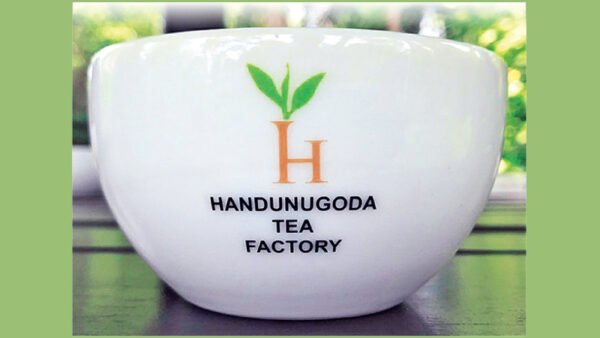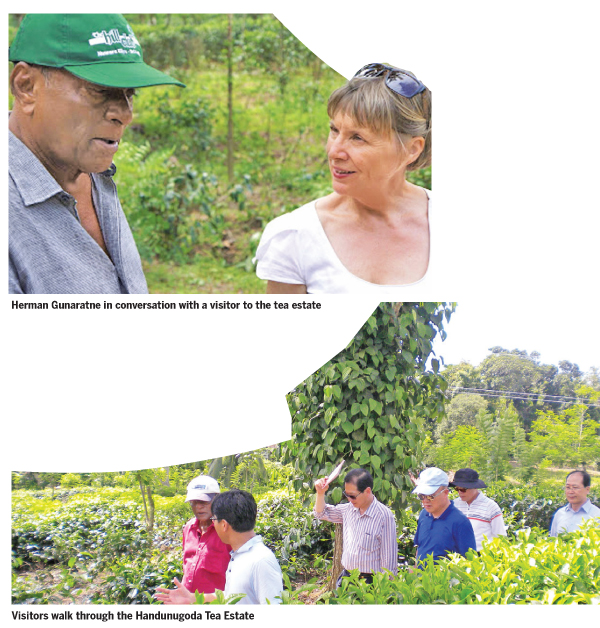As Pure as the Driven Snow-by Shikha Shah

A Handunugoda Estate tea cup
Source:Dailynews
If a certain tea or coffee has a cult following across the world, there is bound to be a fascinating, bizarre, or stomach-churning story behind it. Whether it is the Indonesian Kopi Luwak that is made from partially-digested coffee beans plucked from civet cat’s faeces, Chinese-origin panda poop tea enriched with panda dung or Oolong tea picked by monk-trained monkeys, the world’s rarest and most expensive tea and coffee varieties are either picked on a particular day, in a certain way or have poop or saliva going into them.
 On a misty, rainy afternoon, we are walking around the verdant Handunugoda Tea Estate, a 200-acre tea, rubber, cinnamon, pepper, and coconut estate in Galle in Southern Sri Lanka, about 160 km from Colombo. Since the estate is nestled between an evergreen rainforest and the vast blue Indian Ocean, we can hear soothing bird songs and watch dainty butterflies kissing exotic blooms. The air is ripe with the pleasant petrichor.
On a misty, rainy afternoon, we are walking around the verdant Handunugoda Tea Estate, a 200-acre tea, rubber, cinnamon, pepper, and coconut estate in Galle in Southern Sri Lanka, about 160 km from Colombo. Since the estate is nestled between an evergreen rainforest and the vast blue Indian Ocean, we can hear soothing bird songs and watch dainty butterflies kissing exotic blooms. The air is ripe with the pleasant petrichor.
Owned by veteran, third-generation tea planter Malinga Herman Gunaratne, Handunugoda, is perhaps the only low-country tea plantation in the world that’s within sniffing distance of the sea. However, its bragging rights revolve around its Virgin White Tea, which retails for over US$ 1,500 per kg (INR 120,000), and stocks the shelves of tip-top gourmet tea company Mariage Freres in Paris. Now, what makes Virgin White Tea from Sri Lanka a consistently-produced, highly-prized tea? “To the best of my knowledge, this is the only tea in the world that is completely untouched by hand,” says Gunaratne who has been cultivating tea for 60 long years, initially for large British companies, and later, for the State.
The Virgin White Tea story is fairytale-esque. Legend says that during the fifth and sixth century AD in the dynasties of Emperor Tsong and Tsang, the Chinese mandarins employed virgins to harvest the white tea. The damsels used golden scissors to cut the white tea leaves that fell into a golden bowl. The only part of the human anatomy that touched the tea was (finally) the lips of the emperor. The production of this type of tea was a closely-guarded secret.
Southern Sri Lanka: home of the Virgin White Tea
Gunaratne’s British colleague with some experience in China once acquainted him with the story behind the untainted Oriental tea that was served to the emperor. However, Gunaratne was not quite convinced until he happened to visit Grasse, a town on the French Riviera known for its perfume industry. “I met a nose (a perfumer is often referred to affectionately as a nose due to their fine sense of smell). On a counter, he had displayed small parcels of jasmine flowers from about 15 different countries. I asked him whether they differed in fragrance. His answer was quite astonishing. He said “each smelled unique because of the sweat and oils imparted from the hands of the pickers who had different food habits,” recalls Gunaratne who instantly realised that these pearls of wisdom were known to the ancient Chinese tea masters. He decided to give the idea a shot. In 2009, his Ceylon Virgin White Tea was ready to pour.
There was then an unanticipated occurrence. A Middle Eastern Royal House placed an order for this White Tea with the condition that its ingredients are analysed. The analysis by SGS, a Swiss company, revealed that the white tea had 10.11 percent of antioxidants—the highest in any beverage, present naturally. This
makes it an ideal anti-ageing beverage. The caffeine content was very low. It had no insecticide or pesticide residue. According to medical experts, it is anti-carcinogenic and also an immunity booster.
Perhaps, this is why 78-year-old Gunaratne is fit as a fiddle. He consumes about six cups of Virgin White Tea every single day and frequently makes the rounds of his tea fields on his powerful motorcycle.
Making of the Virgin White Tea
If you happen to drop in at Handunugoda at dawn, you are likely to witness women wielding tiny scissors and plucking the imperial harvest of Camellia sinensis tea trees. These young buds, covered with fine white hair, fall straight into a white ceramic bowl. Today, of course, the concept “virgin” only applies to the tea, not the tea pluckers. “If it was known that I was looking for immaculate girls with golden scissors and golden bowls to harvest tea, my colleagues would have surely thought that I had bats in the belfry!” jokes Gunaratne. At first, the pluckers, in their white shirts, gloves, shower cap, and disposable surgical mask, look like they are dressed for a medical procedure.
“This is to ensure zero contamination of the buds due to human touch, thus keeping the tea pure,” explains our guide S. Sellamuthtu who keeps a safe distance from the white tea bushes while pointing in their general direction. The carefully plucked tea buds are placed in silken pouches to avoid any possible damage to them. Thereafter, these buds are spread over black flannel surfaced trays and dried using only filtered sunlight. The tender bud is never exposed to direct sunlight. When the bud is dried to perfection, the silvery tea leaves are delicately packed by workers wearing soft gloves.

If you are wondering what makes the white tea bush stand out in a plantation of mixed tea bushes. Nothing really. The only difference, at a glance, is that it is darker in colour than its cousins. However, the real difference lies in the amount of tea picked. A standard tea plucker could collect an average of 30 kg on a good day, whereas a Virgin White Tea plucker would meticulously collect only 160 g per day.
At the working tea estate and living museum, we are raising a cup poured with Virgin White Tea, taking in the aroma followed by a small sip, and letting it linger in the mouth for a few seconds. We are swishing the warm liquid over the tip and sides of the tongue, paying great attention to the flavour. The pale, golden-yellow elegant brew is exquisite in taste, sometimes floral, and at other times like champagne. A calming brew, it must be enjoyed and appreciated with all your senses.







